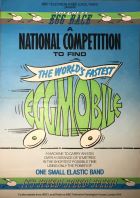The Great Egg Race
(→Pictures) |
MartinSmith (Talk | contribs) |
||
| Line 35: | Line 35: | ||
== Synopsis == | == Synopsis == | ||
| - | + | In the first series contestants had to make an "eggmobile" that could carry an egg for the longest distance powered only by a small rubber band provided by the BBC. In the second series contestants had to make an "eggmobile" that could accelerate from a standing start to cross the finishing line 12 metres away in the shortest possible time using similar, small, BBC provided, rubber bands. Two parallel tracks were provided so that two vehicles could race against each other. The tracks were at table top height and it was no secret that the producers hoped that the odd egg or two would "spectacularly" crash onto the concrete floor. Early heats were organised by BBC local radio stations. Winners and talkative losers were interviewed for local radio airing. The more successful "eggmobiles" were invited to race, perhaps ironically, in the London Transport Museum. These races were televised. | |
| - | The programme went through a number of different formats. | + | Although the idea of getting long distances and fast times was simple considerable ingenuity was required. Stretching the rubber bands to their maximum to store the maximum energy created wheel spin which lost most of the energy. So the more advanced machines incorporated a fusee. This is a conical gear wheel. So when the rubber band was fully stretched it was connected to the smallest diameter of the fusee. When the band had lost most of its energy it was connected to the large diameter portion of the fusee. Thus a constant force was applied to the drive wheels eliminating wheel spin. |
| + | |||
| + | The programme went through a number of different formats. Later series were set larger scale, more advanced challenges. Teams of university boffins would create weird and frequently Heath-Robinson gadgets out of shockingly scant apparatus in order to crack problems like building bridges to support someone's weight, or burglar alarm detectors that people couldn't avoid triggering. | ||
<div class="image"><IMG src="/atoz/programmes/g/great_egg_race/greategg5.jpg" width="195" height="158" border="0"> | <div class="image"><IMG src="/atoz/programmes/g/great_egg_race/greategg5.jpg" width="195" height="158" border="0"> | ||
Revision as of 21:37, 22 January 2025
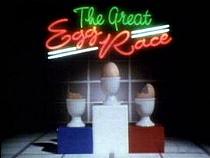
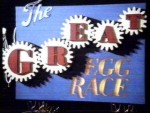
Contents |
Host
Brian Cant and Charlotte Allen (1979)
Johnny Ball (1980)
Hilary Henson (1980-1)
Charlotte Allen (1982)
Heinz Wolff (1983-6)
Lesley Judd (1984)
Howard Stableford (guest presenter)
Co-host
Head judge: Heinz Wolff
Broadcast
BBC2, 2 January 1979 to 12 September 1986 (68 episodes in 8 series)
The Great Egg Race Rides Again BBC Choice, 1 April to 8 July 2000 (13 re-edited episodes)
Synopsis
In the first series contestants had to make an "eggmobile" that could carry an egg for the longest distance powered only by a small rubber band provided by the BBC. In the second series contestants had to make an "eggmobile" that could accelerate from a standing start to cross the finishing line 12 metres away in the shortest possible time using similar, small, BBC provided, rubber bands. Two parallel tracks were provided so that two vehicles could race against each other. The tracks were at table top height and it was no secret that the producers hoped that the odd egg or two would "spectacularly" crash onto the concrete floor. Early heats were organised by BBC local radio stations. Winners and talkative losers were interviewed for local radio airing. The more successful "eggmobiles" were invited to race, perhaps ironically, in the London Transport Museum. These races were televised.
Although the idea of getting long distances and fast times was simple considerable ingenuity was required. Stretching the rubber bands to their maximum to store the maximum energy created wheel spin which lost most of the energy. So the more advanced machines incorporated a fusee. This is a conical gear wheel. So when the rubber band was fully stretched it was connected to the smallest diameter of the fusee. When the band had lost most of its energy it was connected to the large diameter portion of the fusee. Thus a constant force was applied to the drive wheels eliminating wheel spin.
The programme went through a number of different formats. Later series were set larger scale, more advanced challenges. Teams of university boffins would create weird and frequently Heath-Robinson gadgets out of shockingly scant apparatus in order to crack problems like building bridges to support someone's weight, or burglar alarm detectors that people couldn't avoid triggering.
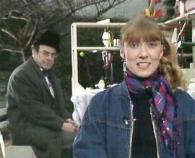 Presenters Heinz Wolff and Lesley Judd
Presenters Heinz Wolff and Lesley JuddMeanwhile, Professor Heinz Wolff would set three other teams challenges to solve. Over the years, the egg racing was dropped and it became a purely challenge-based programme. Later series broke out of the studio, with challenges varying from building a wave machine to taking a photograph of an oil rig using a kite.
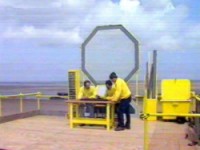
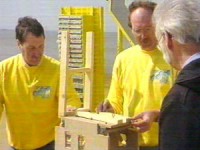 In this episode, the teams built their contraptions on a platform in the (ever-rising) sea tide
In this episode, the teams built their contraptions on a platform in the (ever-rising) sea tideOverall, this show was a small-scale triumph, mainly due to presence of miscellaneous dear heart and general populariser of science Professor Heinz Wolff. He brought a sense of humour to the show, not to mention his distinctive Germanic vowels. Each episode was marked by him and a guest judge using a ludicrously back-of-the-envelope marking scheme. In the later series he hosted the show as well.
Essentially, this was the grand daddy of later shows such as Scrapheap. Remastered 15-minute editions ran for a while on BBC Choice.
Key moments
Once, the teams had to build a combination lock for a door. One team built a lock that was so complex that even they couldn't crack it...
Theme music
Richard Denton and Martin Cook. Here's the full three-minute version on YouTube.
Trivia
On one episode, Heinz was surprised by Tomorrow's World presenter Howard Stableford. Heinz was made one of the team members for a "boffin's team" that was required because that particular programme required four teams (rather than the usual three) in a knockout competition.
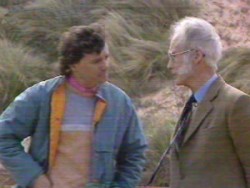 Howard Stableford (left) guest presents one programme
Howard Stableford (left) guest presents one programmeWeb links
Thirteen episodes can be viewed online as part of the BBC Archive (UK only)
Pictures
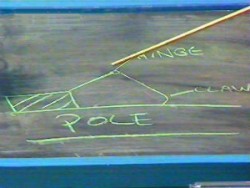 "So, then the green man dives into the pool and the cage comes down..."
"So, then the green man dives into the pool and the cage comes down..."
